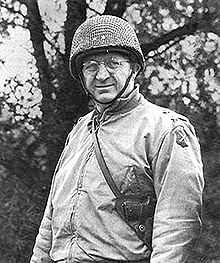Manton S. Eddy
| Lieutenant General Manton Sprague Eddy | |
|---|---|
 | |
| Born |
May 16, 1892 Chicago, Illinois |
| Died |
April 10, 1962 (aged 69) Fort Benning, Georgia |
| Allegiance |
|
| Service/branch |
|
| Years of service | 1916–53 |
| Rank |
|
| Commands held |
114th Infantry Regiment 9th Infantry Division XII Corps |
| Battles/wars |
World War I World War II |
| Awards |
Distinguished Service Cross Silver Star Legion of Merit (2) |
Manton Sprague Eddy (May 16, 1892 – April 10, 1962) was a Lieutenant General of the United States Army.
Early life
Eddy graduated from Shattuck Military School in Faribault, Minnesota in 1913. He enlisted in the U.S. Army in 1916. Thoroughly the infantryman, Manton Eddy served in France in World War I in rifle and machine gun units. Promoted to major, he served in the army of occupation in Germany until 1919 when he returned to the USA. Relegated to captain's rank in 1920, Eddy married Mamie Peabody Buttolph a year later. During the interwar period, he was a member of the Infantry Board and an instructor of tactics at the Command and General Staff College.
World War II
The years of preparation and training returned great dividends to the Army. In 1941 Eddy became commanding officer of the 114th Infantry Regiment. In March 1942, he was promoted to brigadier general and given a second star in July and given command of the 9th Infantry Division in campaigns in Tunisia, Sicily, and Normandy. In August 1944, he became Commander of XII Corps. During the Battle of the Bulge, his units successfully held the southern shoulder of the German salient. In April 1945, he returned to the USA because of illness. For his role in the capture of Cherbourg, Eddy was awarded the Distinguished Service Cross.
Post World War II
In the postwar period, General Eddy served again at Fort Leavenworth, this time as Commandant of the college, from January 1948 to July 1950. He was president of a review board which made a thorough examination of officer education and established the progressive branch, staff, and senior service levels of officer schooling. As Commander of Seventh Army, he presided over its transformation from an army of occupation to one of deterrence. He retired with the rank of lieutenant general.
Manton S. Eddy is buried at Arlington National Cemetery. [1]
Awards and decorations
- Distinguished Service Cross
- Two Distinguished Service Medal
- Silver Star Medal
- Legion of Merit, twice
- Two Bronze Star Medals
- Air Medal
- Purple Heart
- Honorary Companion of the Order of the Bath (United Kingdom)
- Legion of Honor (France)
- Croix de Guerre (France)
- Order of the Patriotic War (Soviet Union)
- Medal "For Courage" (Soviet Union)
- Commander of the Order of Leopold (Belgium)
See Also
References
- Henry Gerard Phillips: The Making of a Professional: Manton S. Eddy, USA, Greenwood Press, 2000, ISBN 0-313-31183-8
- "Manton Sprague Eddy" in Dictionary of American Biography, Supplement 7: 1961-1965. American Council of Learned Societies, 1981
External links
| Military offices | ||
|---|---|---|
| Preceded by Thomas T. Handy |
Commanding General of U.S. Army Europe 12 August 1952 to 1 April 1953 |
Succeeded by Charles L. Bolte |
| Preceded by Oscar Griswold |
Commanding General of the Seventh United States Army August 1950 to August 1952 |
Succeeded by Charles L. Bolte |
| Preceded by Leonard T. Gerow |
Commandant of the Command and General Staff College January 1948 - July 1950 |
Succeeded by Harlan N. Hartness |
|